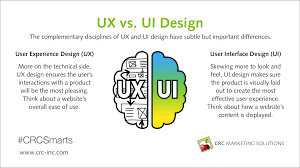Crafting Exceptional User Experiences Through Effective UX Design
The Importance of UX Design in Creating Exceptional User Experiences
User Experience (UX) design plays a crucial role in shaping how users interact with digital products and services. It encompasses the entire process of acquiring and integrating a product, including aspects of branding, design, usability, and function.
Good UX design focuses on creating meaningful and relevant experiences for users. It involves understanding the users’ needs, preferences, and behaviours to tailor the product or service accordingly. By putting the user at the centre of the design process, UX designers can ensure that every interaction is intuitive, efficient, and enjoyable.
One of the key goals of UX design is to enhance user satisfaction by improving the usability, accessibility, and pleasure provided in the interaction with a product. This involves conducting user research, creating wireframes and prototypes, testing designs with real users, and iterating based on feedback.
Effective UX design not only benefits users but also contributes to the success of businesses. A well-designed user experience can lead to increased customer loyalty, higher conversion rates, lower support costs, and overall improved brand perception.
In today’s competitive digital landscape, investing in UX design is no longer optional but essential for staying ahead of the curve. By prioritising user experience throughout the development process, companies can differentiate themselves from competitors and build long-lasting relationships with their customers.
Ultimately, UX design is about creating products that are not only functional but also delightful to use. It is about understanding human behaviour and designing solutions that meet users’ needs in a seamless and engaging way. By embracing UX design principles, businesses can create exceptional user experiences that drive success and foster lasting connections with their audience.
8 Key Benefits of UX Design: Elevating Satisfaction, Loyalty, and Brand Success
- Enhances user satisfaction
- Improves usability and accessibility
- Increases customer loyalty
- Boosts conversion rates
- Reduces support costs
- Strengthens brand perception
- Differentiates from competitors
- Builds long-lasting customer relationships
Challenges in UX Design: Navigating Time, Cost, and User Expectations
- 1. Time-consuming process, especially when conducting extensive user research and testing.
- 2. Costly to implement, particularly for small businesses with limited budgets.
- 3. Subjective nature of user preferences can make it challenging to please all users.
- 4. Constant need for updates and improvements as user expectations evolve over time.
- 5. Balancing business goals with user needs can lead to conflicts in design decisions.
- 6. Overemphasis on aesthetics may overshadow functionality and usability aspects.
- 7. Difficulty in quantifying the ROI of UX design efforts, making it hard to justify investments.
Enhances user satisfaction
Enhancing user satisfaction is a fundamental pro of UX design. By prioritising the needs and preferences of users, UX designers can create experiences that are intuitive, efficient, and enjoyable. When users feel satisfied with their interactions with a product or service, they are more likely to engage with it positively, leading to increased loyalty and trust. A well-crafted user experience that considers every touchpoint can leave a lasting impression on users, ultimately fostering stronger relationships and driving business success.
Improves usability and accessibility
Improving usability and accessibility is a key benefit of UX design. By prioritising these aspects, UX designers ensure that digital products and services are easy to navigate and use for all users, including those with disabilities or limitations. This focus on usability and accessibility not only enhances the overall user experience but also promotes inclusivity and ensures that everyone can interact with the product effectively. By making designs more intuitive and accommodating, UX design helps to break down barriers and create a more user-friendly environment for all individuals.
Increases customer loyalty
One significant advantage of UX design is its ability to increase customer loyalty. By focusing on creating seamless and enjoyable user experiences, businesses can build strong connections with their customers. When users have positive interactions with a product or service, they are more likely to return and become loyal advocates. This loyalty not only leads to repeat business but also helps in attracting new customers through positive word-of-mouth recommendations. Ultimately, by prioritising UX design, companies can foster long-term relationships with their customer base and establish a loyal following that drives sustained success.
Boosts conversion rates
One significant advantage of UX design is its ability to boost conversion rates. By creating a seamless and intuitive user experience, businesses can guide users through the purchasing process more effectively, ultimately increasing the likelihood of conversions. A well-designed website or application that prioritises user needs and preferences can enhance trust, encourage engagement, and streamline the path to conversion, resulting in improved sales and customer satisfaction.
Reduces support costs
One significant advantage of UX design is its ability to reduce support costs for businesses. By creating intuitive and user-friendly interfaces, UX designers can help users navigate products or services with ease, leading to fewer errors and misunderstandings. When users can easily understand and interact with a digital product, they are less likely to require assistance or encounter issues that necessitate costly customer support interventions. This proactive approach to design not only enhances the overall user experience but also contributes to cost savings for companies by minimising the need for extensive customer support resources.
Strengthens brand perception
A significant advantage of UX design is its ability to strengthen brand perception. By focusing on creating seamless and engaging user experiences, companies can enhance how users perceive their brand. A well-crafted and user-friendly interface not only improves customer satisfaction but also builds trust and credibility with users. Consistent positive interactions through effective UX design can leave a lasting impression on users, reinforcing the brand’s image as reliable, innovative, and customer-centric. This positive brand perception can lead to increased loyalty, advocacy, and ultimately contribute to the overall success of the business.
Differentiates from competitors
In the competitive landscape of today’s digital world, one significant advantage of UX design is its ability to differentiate a product or service from competitors. By prioritising user experience and creating intuitive, engaging interfaces, companies can set themselves apart by offering a superior and more enjoyable interaction with their offerings. This differentiation not only attracts and retains customers but also helps in building a strong brand identity that stands out in the market. In essence, investing in UX design allows businesses to carve out a unique position for themselves and stay ahead of the competition by providing exceptional user experiences that leave a lasting impression.
Builds long-lasting customer relationships
User Experience (UX) design excels in building long-lasting customer relationships by prioritising the needs and preferences of users throughout the design process. By creating intuitive and enjoyable experiences, UX design fosters trust and loyalty among customers. When users feel understood and valued through seamless interactions with a product or service, they are more likely to return, recommend the brand to others, and become loyal advocates. This emphasis on customer satisfaction and engagement not only enhances the overall user experience but also contributes to sustainable relationships that drive business success in the long run.
1. Time-consuming process, especially when conducting extensive user research and testing.
One significant drawback of UX design is its time-consuming nature, particularly when conducting thorough user research and testing. The process of gathering insights from users, creating prototypes, and iterating based on feedback can be a lengthy endeavour. Delving deep into understanding user needs and behaviours requires dedicated time and resources, which can sometimes slow down the overall development timeline. Despite its importance in creating effective and user-centric designs, the time investment needed for comprehensive UX processes can be a challenge for projects with tight deadlines or limited resources.
2. Costly to implement, particularly for small businesses with limited budgets.
Implementing UX design can be a significant challenge for small businesses with constrained budgets due to the associated costs. From conducting user research to creating prototypes and conducting usability testing, the expenses involved in the UX design process can quickly add up. Limited financial resources may force small businesses to compromise on the quality of their user experience, potentially impacting customer satisfaction and hindering their ability to compete effectively in the market. Finding cost-effective ways to incorporate UX design principles while staying within budget constraints is essential for small businesses looking to enhance their digital presence and engage with their target audience effectively.
3. Subjective nature of user preferences can make it challenging to please all users.
The subjective nature of user preferences poses a significant challenge in UX design, as it is impossible to create a one-size-fits-all solution that pleases every user. Different individuals have varying tastes, habits, and expectations, making it difficult to cater to everyone’s unique preferences. Designing for such diverse user groups requires careful consideration and trade-offs, as what appeals to one user may not necessarily resonate with another. Balancing these subjective preferences while maintaining a cohesive and effective user experience can be a complex task for UX designers.
4. Constant need for updates and improvements as user expectations evolve over time.
One notable disadvantage of UX design is the constant need for updates and improvements to keep up with evolving user expectations. As technology advances and user preferences shift, what was once considered a seamless and intuitive design may quickly become outdated or inefficient. This ongoing demand for enhancements can be resource-intensive for businesses, requiring continuous evaluation, testing, and refinement to ensure that the user experience remains relevant and engaging. Failure to adapt to changing user needs can result in decreased satisfaction and retention rates, highlighting the challenge of staying ahead in an ever-evolving digital landscape.
5. Balancing business goals with user needs can lead to conflicts in design decisions.
Balancing business goals with user needs in UX design can present a significant challenge, as conflicting priorities may arise when making design decisions. While businesses aim to achieve specific objectives such as increasing revenue or promoting brand awareness, users seek seamless and intuitive experiences that cater to their preferences and behaviours. This conflict can result in compromises that may not fully satisfy either party, potentially impacting the overall effectiveness and user satisfaction of the final product. Finding a harmonious balance between business goals and user needs is essential in creating successful UX designs that align with both strategic objectives and user expectations.
6. Overemphasis on aesthetics may overshadow functionality and usability aspects.
In the realm of UX design, one significant drawback is the risk of prioritising aesthetics over functionality and usability. When there is an overemphasis on visual appeal, the essential aspects of how users interact with a product can be overshadowed. While a visually pleasing design can initially attract users, if it compromises the overall usability and functionality, it can lead to frustration and confusion among users. Striking a balance between aesthetics and usability is crucial in creating a seamless and enjoyable user experience that truly resonates with the audience.
7. Difficulty in quantifying the ROI of UX design efforts, making it hard to justify investments.
One significant challenge of UX design is the difficulty in quantifying the Return on Investment (ROI) of the design efforts, making it challenging to justify investments in this area. Unlike more tangible metrics such as sales or revenue, measuring the impact of UX design on a company’s bottom line can be complex and subjective. This lack of concrete data can lead to hesitation from stakeholders in allocating resources to UX initiatives, despite their potential long-term benefits in enhancing user satisfaction and driving business success.


